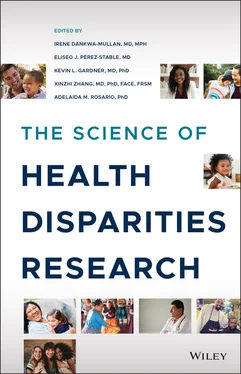The methods researchers employ to promote healthy behaviors, or to engage in prevention to reduce disease, include:
surveillance, epidemiologic study, or other traditional public health tools;
randomized controlled trials, ecological study, or another tested design;
re‐analysis of existing data; and
meta‐analyses or systematic reviews of completed investigations.
What the best studies have in common:
attention directed at a prioritized problem (e.g., adolescent smoking);
a commitment to the most rigorous design applicable (e.g., the randomized controlled trial);
thoughtful statistical approach (e.g., particularly determining the size of the study group so that findings have statistical meaning);
a team of dedicated and well‐trained investigators who may represent many disciplines (e.g., epidemiology, statistics, public health, medicine, nursing, and social work);
recruitment that creates a representative subject population able to produce generalizable results; and
a plan for prompt dissemination of findings and/or replication of successful interventions.
Some samples include:
a randomized trial to test a physical activity intervention for Latinas;
a statistical study to identify and characterize a minority population with high rates of colorectal cancer;
a re‐analysis of national survey data to identify differences in behavioral factors and breast cancer status according to race and ethnicity; and
an experiment with computer simulation to create a reliable model of behavior change.
A foundational premise must be a commitment to appreciating and respecting all aspects of the beliefs, values, and traditions of the communities of interest, and being responsible in obtaining the cultural competence to work with them. Any researcher needs to be concerned about the effect of participation on the community and whether necessary and sufficient support is available to communities to sustain any changed behavior introduced by an intervention.
This is especially true in terms of precision medicine and precision prevention. Making precision medicine and prevention available to large populations requires the participation and inclusion of a diverse patient population, and not just those who can afford it and have ready access to care. Most research data are extracted from uniform study populations composed largely of White men, though the minority population of the United States is approaching 40%. Members of these groups cannot fully benefit from advances in cancer treatment, especially in this era of precision medicine. Minority representation in clinical trials is less than 5%, and according to a review of clinical trials from 2000 to 2010, only 2.2% of participants were Latino [27]. This calls for a large area of improvement to empower minority communities toward positive attitudes and beliefs in research and clinical practices through increased promotion and knowledge of clinical trials, active participation in research protocols, and involvement in transdisciplinary and translational partnerships for better minority health outcomes.
4.4 State of the Science: Promising Practices
Promising practices in behavioral determinants research, described below, rely on both new and tried‐and‐true methods. Rather than toiling within the confines of traditional academic practice with a single team, some researchers are creating consortia and combining multiple teams to address significant health behaviors. An evolving approach is incorporating technology into interventions. Health technology is transforming everyday tools for research, or for directly promoting health‐enhancing behavior.
These include more than just uses for the electronic health record (EHR) and smartphones. Promising practices also include respectful responses to underserved constituencies that build trust and the creative concept of public health advocates influencing legislation by bringing together a broad coalition of partners across the state to create a sustainable investment in community‐level population health strategies to advance the cycle of better care, better health, and lower costs [28, 29].
CBPR also should be included on the list of promising practices. In addressing the disproportionate and growing burden of health disparities among minority and lower socioeconomic populations, CBPR has shown great promise. Researchers, practitioners, and community partners who have participated in CBPR projects have been able to point to the success that results when everyone is able to fully integrate their talents, resources, and expertise toward a common goal [30].
In response to the high prevalence of obesity in Latino children and adolescents, researchers at the Institute for Health Promotion Research at the University of Texas Health Science Center at San Antonio, buoyed by support from the Robert Wood Johnson Foundation, led the creation of Salud America! The National Research Network to Prevent Obesity among Latino Children. In its first few years, Salud America! formed a national advisory committee, selected 20 pilot study investigators, and presented a Latino childhood obesity research priority agenda [31]. Investigators received an average of $75 000 to develop and implement promising policy‐relevant strategies to prevent and reduce obesity among Latino children. Awards were made across the country. Investigators believed the need for research and intervention was urgent because: childhood and adolescent overweight and obesity portend a propensity to adult overweight and obesity; healthcare costs rise dramatically for obese adults who were not at a healthy weight in childhood; and Latino children are vulnerable to marketers hawking unhealthy food to youth through television, social media, and other outlets.
One pilot investigator's approach included Photovoice, which encouraged parents and children to use photography to identify patterns or themes within their communities that were barriers to physical activity and root causes of inactivity. Among barriers participants noted were lack of access to activity programs outside school hours, lack of transportation, and communication problems. This involvement prompted them to make proposals for solutions within the community.
Other initiatives brought together mothers and daughters for physical activity; taught families about nutrition and how to evaluate grocery purchases; profiled understudied migrant farmworkers' children, almost half of whom were at unhealthy weights; and linked greater physical activity with higher performance in math. Others assessed the built environment, and still others addressed crime as an inhibitor of physical activity [10].
A second phase shifted Salud America! efforts into advocacy and policy development based on the evidence [31]. The program developed a Policy Contribution Spectrum to identify and describe the stages of policy development. Program leaders then developed an online multipronged strategy—research reviews, culturally relevant digital content curation, stories, videos, and action items in key aspects of Latino child and family health [10]—to inspire people to start and support healthy changes to policies, systems, and environments where Latino children and families can equitably live, learn, work, and play. The Salud America! program uses this content to fuel its social and online network of more than 125 000 moms and dads, providers, researchers, and community and school leaders to push for healthy changes in schools and communities for Latinos and all kids.
Overall, the Institute for Health Promotion Research team has created more than 100 national, statewide, local, and private research programs. The work not only produced results but also has generated new investigators, new funds, wider interest, and awards. The Institute has pursued expansion of Latino health initiatives, including research in childhood obesity [31], work in tobacco cessation among young adults [32], action on hepatocellular cancer [33], and attention to cancer health disparities in a recently launched national initiative [27].
Читать дальше












